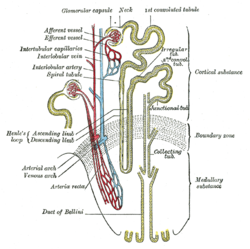Nephron
|
|
A nephron is the basic structural and functional unit of the kidney. It is a tiny tubule consisting of a cluster of capillaries called the glomerulus, surrounded by a hollow bulb known as Bowman's capsule. Bowman's capsule leads into a long, convoluted tubule consisting of four sections: the proximal tubule, loop of Henle, distal tubule, and collecting duct. The collecting ducts empty into the central cavity of the kidney, the renal pelvis, which connects to the ureter. Each human kidney has about a million nephrons.
The basic function of the nephron is to regulate water and soluble substances (especially ions) in the body by filtering it all out first, reabsorbing what should be kept and excreting the rest. This is a function vital to supporting human life.
The nephron filters the blood by several processes concentrating the filtrates, reabsorbing ions (such as sodium, potassium, calcium, hydrogen, bicarbonate, chloride, and ammonium ions), solutes (such as glucose, amino acids, phosphates, and so on) according to the body's needs under hormonal control, or from anti-diuretic hormones, aldosterone, parathyroid hormone, atrial-natriuretic peptide and others. In this process urine is produced, and in doing so, eliminates wastes from the body, regulates blood volume and blood pressure, regulates the levels of important electrolytes and metabolites and regulates blood pH levels.
| Contents |
Bowman's capsule
The Bowman's capsule is the beginning of the nephron and encloses the glomerulus. The glomerulus is a ball of capillaries imbetween the afferent and efferent arterioles of the renal circulation. The barrier between the blood and the lumen of the nephron here is formed of 3 layers: the squamous endothelium of the capillaries; the basement membrane; and the endothelial podocytes forming the nephron. The barriers are 'leaky' in the sense that relatively large molecules can pass through unfiltered.
The process of filtration of the blood in the Bowman's capsule is ultra-filtration or glomerular filtration, the normal rate of glomerular filtration is 125 ml/min, equivalent to 10x the blood volume daily. Any proteins under ~daltons in size can pass freely through the membrane, although there is some extra hindrance for negatively charged molecules due to the negative charge of the basement membrane and the podocytes. Any small molecules such as water, glucose, salt(NaCl), amino acids and urea pass freely into the nephron but cells, platelets and large proteins do not.
The filtrate leaving the Bowman's capsule is very similar to plasma fluid in composition and passes on into the distal convoluted tubule.
Proximal tubule
The proximal tubule reabsorbs fluid in bulk from the filtrate, including 2/3 filtered salt and water and all filtered organic solutes (primarily glucose and amino acids). This is driven by Na+ transport from the lumen into the blood by the Na+/K+ ATPase in the basolateral membrane of the epithelial cells. Much of the mass movement of water and solutes occurs imbetween the cells through the 'tight junctions' that in this case are not selective.
The solutes are absorbed isotonically, in that the osmotic potential of the fluid leaving the proximal tubule is the same as that of the blood. However glucose and amino acids are absorbed actively via co-transport channels driven by the Na+ gradient out of the nephron.
Loop of Henle
- Main article Loop of Henle
The loop of Henle descends from the cortex into the medulla, and then ascends back from the medulla to the cortex only in juxtamedullary nephrons. In other nephrons, the loop merely extends through the kidney's cortex. The longer the nephron, the better it performs its countercurrent exchange mechanism involving the loop of Henle in the medulla allows reabsorption of water and salt. By this point, only 6% of original water and 4% of original salt remains.
Distal tubule
- Main article distal tubule
The distal tubule is similar to the proximal tubule. Salt is pumped out and water follows by osmosis. After travelling through the distal tubule, only 3% of water remains, and the remaining salt content is negligible. A third process (in addition to filtration and reabsorption) takes place: secretion. Hydrogen and potassium ions are actively transported from the blood into the urine to be excreted.
Collecting duct
The collecting duct goes deep into medulla, and as much as ¾ of the remaining water can be reabsorbed as the urine travels through the collecting duct. But in reality, the amount of water reabsorbed is dependent on the permeability of the walls of the duct, regulated by ADH secreted by the posterior part of the pituitary gland. The more ADH, the more permeable the ducts, the more water reabsorbed; the less ADH, the less permeable the ducts, the less water reabsorbed. This is related to the high osmolarity of the interstitium due to the countercurrent muliplyer system of the loops of Henle.
Dehydration results in an increase in ADH, while water sufficiency results in low ADH allowing for diluted urine. Lower portions of the collecting duct are also permeable to urea, allowing some of it to enter the medulla of the kidney, thus maintaining its high ion concentration (which is very important for the nephron).
See also
de:Nephron es:Nefrona fr:Néphron nl:Nefron pl:Nefron pt:Nefrónio

